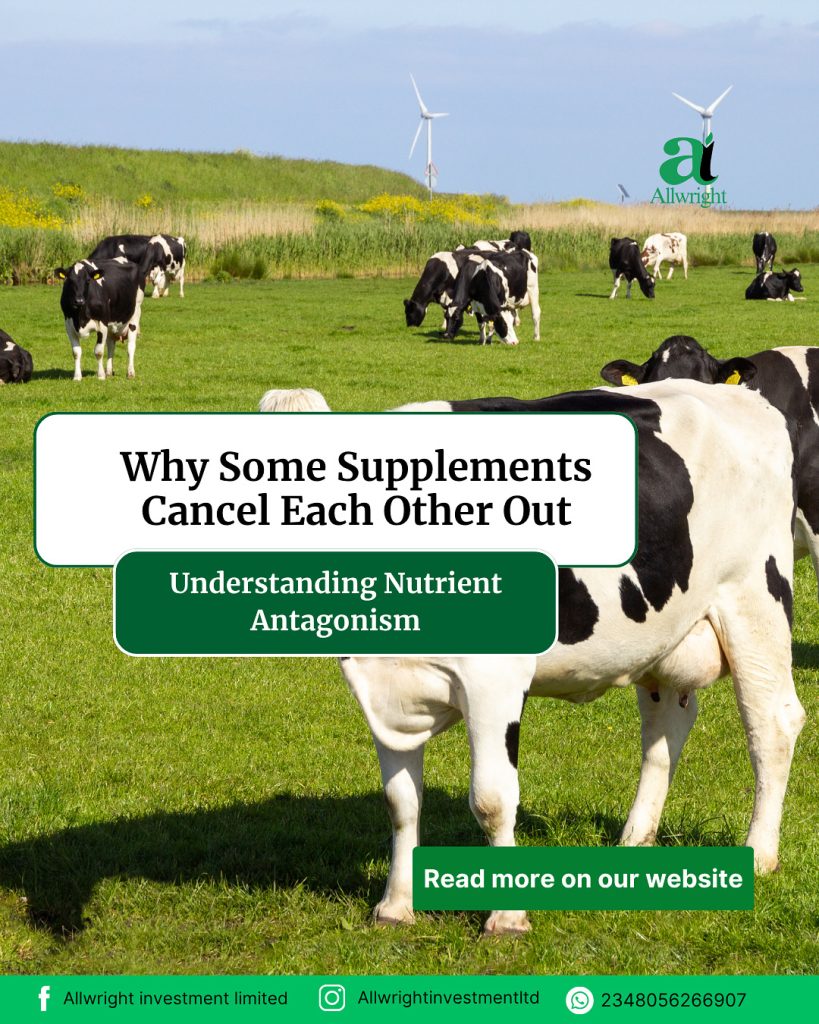
Why Some Supplements Cancel Each Other Out: Understanding Mineral Antagonism
Navigating livestock nutrition can feel like a complex chemistry experiment. You’re providing all the right supplements, but sometimes, the results don’t add up. The hidden culprit? Mineral antagonism—when certain minerals compete with each other for absorption in your animals’ bodies.
The Science of Mineral Competition
Think of your animal’s digestive system as a busy highway with limited entry points. Minerals often use the same “on-ramps” (absorption pathways) to enter the bloodstream. When two minerals compete for the same pathway, the one that’s more abundant or has a stronger “affinity” typically wins, leaving the other mineral to pass through undigested.
This isn’t just inefficient—it can create deficiencies even when you’re providing adequate amounts in the feed.
Key Mineral Antagonisms Every Producer Should Know
- The Copper Thieves: Molybdenum & Sulfur
The Interaction:
· Molybdenum and sulfur combine in the rumen to form thiomolybdates
· These compounds bind with copper, creating an unavailable complex
· The result? Copper deficiency despite adequate supplementation
Real-World Impact:
· Poor coat quality
· Reduced fertility
· Weak immune function
· Depressed growth rates
The Fix:
· Maintain a copper-to-molybdenum ratio of 4:1 to 6:1
· Increase copper supplementation in high-molybdenum areas
· Consider more bioavailable copper sources (copper proteinate)
- The Calcium Effect: Zinc & Manganese
The Interaction:
· High calcium levels can reduce absorption of both zinc and manganese
· These minerals share similar absorption pathways in the intestine
· Particularly problematic in rapidly growing animals and high-producing dairy cows
Real-World Impact:
· Hoof problems and lameness (zinc deficiency)
· Poor reproductive performance (manganese deficiency)
· Reduced growth rates
The Fix:
· Maintain proper calcium-to-phosphorus ratios (typically 2:1)
· Increase zinc and manganese levels in high-calcium diets
· Use organic mineral sources for better absorption
- The Iron Barrier: Phosphorus & Copper
The Interaction:
· Excess iron can reduce phosphorus availability
· High iron also interferes with copper absorption
· Common in areas with high iron in water or soil
Real-World Impact:
· Bone development issues (phosphorus deficiency)
· Copper deficiency symptoms (see above)
· Reduced feed efficiency
The Fix:
· Test water sources for iron content
· Adjust mineral programs based on environmental iron levels
· Consider water treatment if iron levels are excessive
Building a Balanced Mineral Program
Step 1: Know Your Starting Point
· Test your forages—mineral content varies dramatically
· Analyze water sources—don’t forget this hidden mineral contributor
· Understand your soil—regional deficiencies matter
Step 2: Choose the Right Forms
· Organic minerals (chelates, proteinates) often have better bioavailability and are less susceptible to antagonism
· Inorganic minerals (oxides, sulfates) are more affordable but more prone to interactions
Step 3: Implement Smart Formulation Strategies
· Balance ratios, not just levels—it’s about relationships between minerals
· Consider timing—some minerals can be fed at different times to reduce competition
· Use protected forms—rumen-protected minerals bypass some antagonism
Common Signs of Mineral Imbalance
🚩 Poor coat quality → Check copper-zinc-iron balance
🚩 Reduced fertility → Evaluate manganese, zinc, and copper
🚩 Bone or hoof issues → Review calcium-phosphorus-zinc ratios
🚩 Unexplained performance plateaus → Comprehensive mineral audit needed
The Cost of Getting It Wrong
Mineral antagonism isn’t just a theoretical concern—it has real economic consequences:
· Wasted supplement dollars on minerals that never get absorbed
· Hidden production losses from subclinical deficiencies
· Increased veterinary costs treating deficiency-related conditions
· Reduced reproductive efficiency and longer calving intervals
Smart Solutions for Modern Producers
Work With What You Have
· Formulate supplements based on your specific forage test results
· Adjust for regional challenges (high iron water, selenium-deficient soils)
· Consider seasonal variations in mineral availability

Leave a comment
You must be logged in to post a comment.